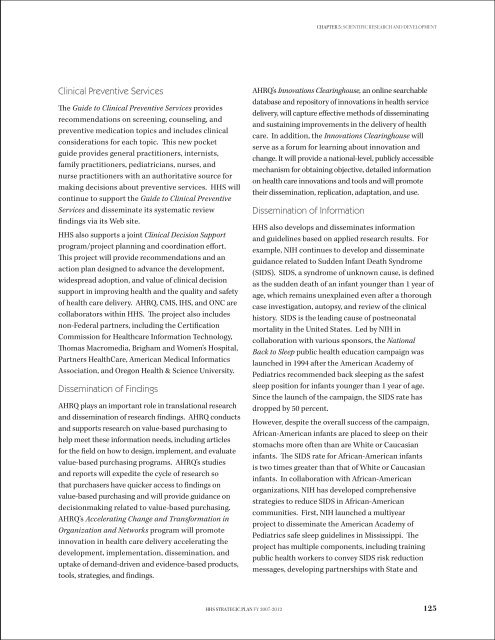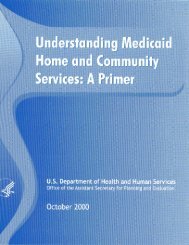STRATEGIC PLAN - ASPE - U.S. Department of Health and Human ...
STRATEGIC PLAN - ASPE - U.S. Department of Health and Human ...
STRATEGIC PLAN - ASPE - U.S. Department of Health and Human ...
You also want an ePaper? Increase the reach of your titles
YUMPU automatically turns print PDFs into web optimized ePapers that Google loves.
CHAPTER 5: Scientific Research <strong>and</strong> DevelopmentClinical Preventive ServicesThe Guide to Clinical Preventive Services providesrecommendations on screening, counseling, <strong>and</strong>preventive medication topics <strong>and</strong> includes clinicalconsiderations for each topic. This new pocketguide provides general practitioners, internists,family practitioners, pediatricians, nurses, <strong>and</strong>nurse practitioners with an authoritative source formaking decisions about preventive services. HHS willcontinue to support the Guide to Clinical PreventiveServices <strong>and</strong> disseminate its systematic reviewfindings via its Web site.HHS also supports a joint Clinical Decision Supportprogram/project planning <strong>and</strong> coordination effort.This project will provide recommendations <strong>and</strong> anaction plan designed to advance the development,widespread adoption, <strong>and</strong> value <strong>of</strong> clinical decisionsupport in improving health <strong>and</strong> the quality <strong>and</strong> safety<strong>of</strong> health care delivery. AHRQ, CMS, IHS, <strong>and</strong> ONC arecollaborators within HHS. The project also includesnon-Federal partners, including the CertificationCommission for <strong>Health</strong>care Information Technology,Thomas Macromedia, Brigham <strong>and</strong> Women’s Hospital,Partners <strong>Health</strong>Care, American Medical InformaticsAssociation, <strong>and</strong> Oregon <strong>Health</strong> & Science University.Dissemination <strong>of</strong> FindingsAHRQ plays an important role in translational research<strong>and</strong> dissemination <strong>of</strong> research findings. AHRQ conducts<strong>and</strong> supports research on value-based purchasing tohelp meet these information needs, including articlesfor the field on how to design, implement, <strong>and</strong> evaluatevalue-based purchasing programs. AHRQ’s studies<strong>and</strong> reports will expedite the cycle <strong>of</strong> research sothat purchasers have quicker access to findings onvalue-based purchasing <strong>and</strong> will provide guidance ondecisionmaking related to value-based purchasing.AHRQ’s Accelerating Change <strong>and</strong> Transformation inOrganization <strong>and</strong> Networks program will promoteinnovation in health care delivery accelerating thedevelopment, implementation, dissemination, <strong>and</strong>uptake <strong>of</strong> dem<strong>and</strong>-driven <strong>and</strong> evidence-based products,tools, strategies, <strong>and</strong> findings.AHRQ’s Innovations Clearinghouse, an online searchabledatabase <strong>and</strong> repository <strong>of</strong> innovations in health servicedelivery, will capture effective methods <strong>of</strong> disseminating<strong>and</strong> sustaining improvements in the delivery <strong>of</strong> healthcare. In addition, the Innovations Clearinghouse willserve as a forum for learning about innovation <strong>and</strong>change. It will provide a national-level, publicly accessiblemechanism for obtaining objective, detailed informationon health care innovations <strong>and</strong> tools <strong>and</strong> will promotetheir dissemination, replication, adaptation, <strong>and</strong> use.Dissemination <strong>of</strong> InformationHHS also develops <strong>and</strong> disseminates information<strong>and</strong> guidelines based on applied research results. Forexample, NIH continues to develop <strong>and</strong> disseminateguidance related to Sudden Infant Death Syndrome(SIDS). SIDS, a syndrome <strong>of</strong> unknown cause, is definedas the sudden death <strong>of</strong> an infant younger than 1 year <strong>of</strong>age, which remains unexplained even after a thoroughcase investigation, autopsy, <strong>and</strong> review <strong>of</strong> the clinicalhistory. SIDS is the leading cause <strong>of</strong> postneonatalmortality in the United States. Led by NIH incollaboration with various sponsors, the NationalBack to Sleep public health education campaign waslaunched in 1994 after the American Academy <strong>of</strong>Pediatrics recommended back sleeping as the safestsleep position for infants younger than 1 year <strong>of</strong> age.Since the launch <strong>of</strong> the campaign, the SIDS rate hasdropped by 50 percent.However, despite the overall success <strong>of</strong> the campaign,African-American infants are placed to sleep on theirstomachs more <strong>of</strong>ten than are White or Caucasianinfants. The SIDS rate for African-American infantsis two times greater than that <strong>of</strong> White or Caucasianinfants. In collaboration with African-Americanorganizations, NIH has developed comprehensivestrategies to reduce SIDS in African-Americancommunities. First, NIH launched a multiyearproject to disseminate the American Academy <strong>of</strong>Pediatrics safe sleep guidelines in Mississippi. Theproject has multiple components, including trainingpublic health workers to convey SIDS risk reductionmessages, developing partnerships with State <strong>and</strong>HHS Strategic Plan FY 2007-2012125
















